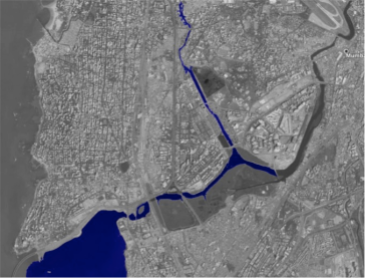Negotiating the Estuarine Landscape
- Saloni Vora
- Jun 12, 2019
- 4 min read
Case | Vakola Nalla
Studio Mentors: Ravindra Punde, Dipti Bhaindarkar, Sabaa Giradkar, Malak Singh Gill, Faizan Khatri, Gauri Satam
Lifeline to the city
With a defying responsibility
They called me,
The Mighty Mithi!
Serving to the city
Taking reclamation, waste and negotiations
Years down the line
Am I still the Mighty Mithi?
Narrow is the flow
In danger is the biodiversity
I fear the day
When they will say
There Was, a Mighty Mithi!
– Saloni Vora, Student, Sem VI, Batch 2018-19
The above poem very crisply states the consequential condition of the Mithi River. Once a river has now turned into sewer post reclamation of island: Mumbai. With industries and slums emerging alongside led to the degradation of the river due to disposal of garbage and different pollutants into the river. The concretization led to the reduction in the sponge condition of the ground, allowing flooding which very evidently struck the city life in 2005.
1947 2005
Semester VI design project was an attempt to investigate the possibility of negotiating with the estuarine landscape. Vakola Nallah which is a major tributary to Mithi River was chosen as the focus area. It originates north of Santacruz downstream the airport, passes alongside the Mumbai University campus, slums settlement on both sides finally opening into the Mithi River. As different conditions prevail alongside the Nallah and river, three different sites were chosen for designing a library cum knowledge centre;
1.In the University Campus – Academic Institutional Library
This investigated as to how the intervention will be set in the present ground condition
2. At the Edge – Community Library
This investigated as to how the intervention will be set in the present ground condition adjoining a large informal settlement.
3. At the Confluence of the highway, Bandra Kurla Complex
This demanded attention to noise, edge, high accessibility and answers to traffic confluence of road, foot over bridge and pedestrian paths.
The project had to respond to the micro conditions within and around each site. The studio head started with all students visiting and documenting the three sites under various heads of Terrain, Vegetation, Community, Development, Quantitative Analysis: Air, Land, Water.
Each student had one condition to engage with and address to. With independent approach with individual learning’s to the prevailing condition, each student came up with their idea of what a library or a knowledge centre is in the given context. Around 1300 sq.m of area, activities requirement was given. Students were given a free hand at deriving another 1200 sq.m area and design program in addition. So as to go about the 6 week design studio, the students intermittently responded to the following three questions as milestones to the project,
What is a library in the given context?
How does the context determine your space, form and relation to the ground?
What is the appropriate materiality, systems and relation of the built form?
The reviews, discussions with the students and amongst the faculty were strengthened by conducting readings in the studio. This opened up the students to more of the global discussions on water crisis, climate change and how different stakeholders are addressing it. The tectonics has found its way to address global warming but the book ‘The Great Derangement: Climate Change and the Unthinkable’ by Amitav Ghosh opened up about how we as humans are lacking imagination and how this crisis requires immediate collective action for desired better future. The other readings that triggered the design thinking were;
The Ethical implications of Global Climate Change by COMEST (World Commission on the Ethics and Scientific Knowledge and Technology)
Report by the Commission on the Measurement of Economic Performance and Social Progress by Prof. Joseph E. Stiglitz, Chair, Columbia University; Prof Amartya Sen, Chair Advisor, Harvard university;Prof Jean – paul FITOUSSI, Coordinator of the Commission, IEP
India’s Intended nationally determined Contribution :Working towards climate justice by MOEFCC (Ministry Of environment and Forests and Climate Change), India
The Paris Agreement :A New Beginning , Journal for European Environmnetal and Planning Law 13 (2016) by Charlotte Streck, Paul Keenlyside, Moritz von Unger
Too much Too little : Understanding the Water crisis in Indian Subcontinent by David Dillard- Wright and Sbrina D. Misirhialall
SOAK: Mumbai in an Estuary by Anuradha Mathur and Dilip da Cunha
Sabarmati Riverfront Development Feasibility report by Environmental Planning Collaborative (EPC)
While conducting a reading in the studio, one of the students spoke about his ardent observation on the site. He narrated that the site which was once a dense mangrove now has some vacant patch of land. It is used by the neighbouring slum settlement for open defecation and also had an open sewage drain passing through. He said “I saw that the land was bad in state and it stinked; but I also saw there were pigs around it. So now I wonder if I have to design a library here, will that mean I let go of the habitat of those pigs.” This question did struck the faculty and made us aware that the students are intrinsically being sensitised towards the existence of all forms of living beings.
Some of the Responses by the Students

Shrushti Karale |A16 Batch | 2018-19 | Semester

Manish Shravane | A16 Batch | 2018-19 | Semester 6














Comments